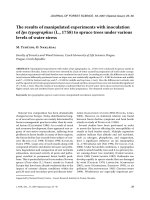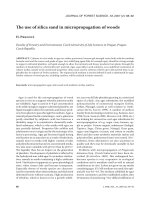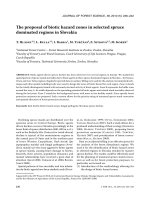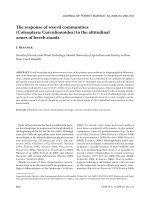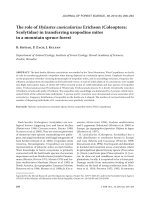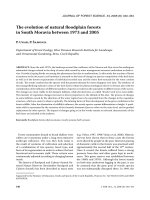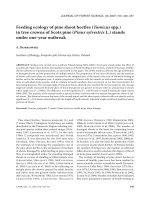Báo cáo lâm nghiệp: "The role of Hylastes cunicularius Erichson (Coleoptera: Scolytidae) in transferring uropodine mites in a mountain spruce forest" pptx
Bạn đang xem bản rút gọn của tài liệu. Xem và tải ngay bản đầy đủ của tài liệu tại đây (253.56 KB, 7 trang )
258 J. FOR. SCI., 56, 2010 (6): 258–264
JOURNAL OF FOREST SCIENCE, 56, 2010 (6): 258–264
Bark beetles (Coleoptera: Scolytidae) are eco-
logical factors triggering tree and forest decline
(B 1986; C, B 1988;
S et al. 2003). ey are vectors (phoronts)
of numerous mite species transmitting tree patho-
gens, mycangial symbionts and fungal antagonists of
bark beetles (M et al. 2005). Uropodine mites
(Acarina, Mesostigmata: Uropodina) are typical
representatives of phoretic mites on bark beetles.
eir knowledge in forest ecosystems is primarily
connected with the bark beetle species of economic
importance such as Dendroctonus frontalis Zimmer-
mann (M, R 1971; M 1976) and Sco-
lytus multistriatus Marsham (H et al. 1985) in
North America, Ips typographus Linnaeus (M,
B 1984; M et al. 1989a,b; K-
, M 1994), Scolytus multistriatus
and
S. pygmaeus (Fabricius) (M et al. 2005) in
Europe, Ips typographus japonicus Niijima in Japan
(M et al. 1997).
H. cunicularius (Coleoptera: Scolytidae) has a
wide distribution in coniferous forests in Europe
and Asia (Siberia and Caucasus) (P 1989;
J et al. 1994). It is frequent and abundant
in lowland and mountain areas, everywhere where
its principal host plants Norway spruce (Picea abies
[L.] Karst.) and Scots pine (Pinus sylvestris [L.]) oc-
cur. In clear-cut and windthrow areas or in forest
plantations, locally, it is reported to be a forest pest.
Damage results from maturation feeding of adult
beetles on the bark of young coniferous trees (P-
et al. 1954; P 1955, 1995; S
e role of Hylastes cunicularius Erichson (Coleoptera:
Scolytidae) in transferring uropodine mites
in a mountain spruce forest
B. K, P. Z, J. K
Department of Animal Ecology, Institute of Forest Ecology, Slovak Academy of Sciences,
Zvolen, Slovakia
ABSTRACT: e bark beetle Hylastes cunicularius was studied in the Tatra Mountains, West Carpathians, to clarify
its role in transferring phoretic uropodine mites during dispersal in a mountain spruce forest. Emphasis was placed
on the proportion of beetles vectoring deutonymphs of uropodine mites, and on assemblage structure, frequency dis-
tribution and placement of uropodids on the bark beetle vector. A total of 3,302 adults of
H. cunicularius were caught
into flight interception traps, of which 529 (16%) vectored a total of 1,020
individuals and four species of uropodine
mites: Trichouropoda pecinai Hirschmann & Wisniewski, Trichouropoda obscura (C.L.Koch), Uroobovella vinicolora
(Vitzthum), Uroobovella ipidis (Vitzthum). e uropodine mite assemblage was dominated by T. pecinai, which repre-
sented 94.6% of the collected mite individuals. T. pecinai and U. vinicolora were documented as new associates of H.
cunicularius. Frequency distribution of uropodids on the beetle was L-shaped. e number of vectored mites and the
number of dispersing individuals of H. cunicularius were positively correlated.
Keywords: Hylastes cunicularius; mountain spruce forest; uropodine mites; West Carpathians
Suported by the Slovak Research and Development Agency, Project No. APVV 0456-07, and by the Scientific Grant Agency
(VEGA) of the Ministry of Education of the Slovak Republic, Grants No. 2/0110/09 and 2/0130/08.
J. FOR. SCI., 56, 2010 (6): 258–264 259
1974; E et al. 1991; W et al.
2002). Hylastes species act as vectors of fungal tree
pathogens worldwide (W et al. 1986; L,
A 1986; F, F 1987). e
adults of H. cunicularius transmit ophiostomatoid
fungi (M-K 1953; K 2007)
and transfer phoretic uropodine mites (H
1971; K, S 2000).
The literature is scant concerning the transfer
of uropodids by H. cunicularius in spruce forests.
To clarify the role of H. cunicularius as a vector
of phoretic uropodine mites during dispersal in a
mountain spruce forest, the following questions have
been addressed:
(1) what is the proportion of beetles vectoring uro-
podine mites in the beetle population?,
(2) what is the species composition and diversity of
uropodine mite assemblage on the beetle?,
(3) which type of frequency distribution charac-
terizes distribution of uropodine mites on the
beetle?,
(4) how are predominant uropodid species located
on the beetle?
e questions are of considerable biological interest
for understanding the role of H. cunicularius in trans-
ferring phoretic uropodids by the beetle vector.
MATERIAL AND METHODS
Study area and sample plots
e study was carried out in the Tatra Mountains,
West Carpathians, Central Europe, in three separate
sample plots established in the valleys Tomanova
dolina (1,280–1,360 m a.s.l.), Velická dolina (1,460
to 1,520 m a.s.l.) and Bielovodská dolina (1,360 to
1,560 m a.s.l.) in 2004. e plots represent the for-
est area of approximately 170 km
2
. ey are Norway
spruce-dominated (share of spruce 95%) forest re-
serves with frequent occurrence of dying and dead
trees, the latter in the form of decaying trunks and
logs on the ground or snags. Dwarf pine (Pinus
mugo Turra), European larch (Larix decidua Miller),
Arolla pine (Pinus cembra [L.]), rowan (Sorbus
aucuparia [L.]) and different willow species (Salix
spp.) occur locally, sharing the rest 5%. e ground
layer is typically formed by raspberry (Rubus idaeus
[L.]), bilberry (Vaccinium myrtillus [L.]) and other
mountain plants. Forest structure (canopy 50–80%)
is modified by the wind, avalanches and bark beetles,
of which Ips typographus (L.) is the most important
with regard to spruce forest decline. Only a slight
alteration of forest structure by man (tree felling,
timber removal) can be noticed locally.
Sampling bark beetles and deutonymphs of uro-
podine mites
Window flight trapping was used as the sampling
method. A total of 6 flight interception traps were
set for bark beetles and other invertebrates in each
sample plot. Traps were fixed to spruce trees which
were 0.4–0.5 m thick at dbh, characterized by com-
plete needle loss in the crown and presence of fresh
wounds on lower parts of trunks, at heights of 1.3–1.6
m, measured from the ground to the lower margin
of trap panes. In each sample plot they were posi-
tioned at a distance of 100–150 m, on two vertical
transects which were approximately 200 m distant
from each other. Traps consisted of two transpar-
ent acrylic panes (0.4 × 0.6 m each) crossed at right
angles, a circular dark green funnel (diameter 0.4 m)
placed below the panes, and a collector containing
water, coarse salt (NaCl) and a few drops of deter-
gent. Salt preserved invertebrates, detergent reduced
the surface tension of the solution in trap collectors.
Traps were emptied at the end of each month, over
the period 15
th
May–30
th
September 2004.
In the laboratory, the individuals of H. cunicularius
were separated from other organic material sampled
in traps and placed in vials containing 70% ethanol.
Then, they were examined for deutonymphs of
uropodine mites. e deutonymphs were extracted
from the beetles manually, using pincers. ey were
mounted into microscopic slides, each specimen
separately using Liquido de Swan, and kept prepared
for determination and further study.
Individuals of H. cunicularius were identified ac-
cording to P (1989, 1995), deutonymphs of
uropodine mites according to M (2001).
Data analysis
Proportion of H. cunicularius adults vectoring
uropodine mites
Two groups were distinguished in the population
of H. cunicularius with regard to the transfer of
uropodine mites: (1) individuals vectoring mites and
(2) individuals not vectoring mites. Testing for dif-
ferences in the number of individuals between group
1 and group 2 was performed using the Wilcoxon
test for two groups arranged as paired observations.
It was resorted to the nonparametric test as the
data did not meet the assumptions of parametric
methods of data analysis after transformation. Next,
the proportion of mite vectors in the population of
H. cunicularius was calculated as a percentage of
the beetles sampled. Spearman’s coefficient of rank
260 J. FOR. SCI., 56, 2010 (6): 258–264
correlation (R) was used to test for the significance
of the association between the number of vectored
mites and the number of dispersing individuals
of H. cunicularius. The nonparametric test was
employed for this relationship as the data did not
conform to a bivariate normal distribution (
S,
R 2000). Statistical analyses were performed in
the STATISTICA 7.0 program (StatSoft 2005).
Species composition and diversity of uropodine
mite assemblage
e assemblage structure of uropodine mites on
H. cunicularius was characterized by abundance
and dominance of abundance of mite species re-
corded in particular sample plots over the period
15
th
May–30
th
August 2004 (no beetles were caught
in September). Diversity of uropodine mite assem-
blages on the beetle vector was characterized by
Simpson’s diversity index (S 1949) (Table 1).
Rarefaction analysis was done to clarify the relation-
ship between the number of mite species and the
number of mite individuals collected in the study
area (Fig. 1). Computation of diversity index and
rarefaction were performed in the PAST program
(H et al. 2009).
Frequency distribution of uropodine mites
To characterize the frequency distribution of uro-
podine mites on H. cunicularius a bar diagram was
constructed. In the diagram, numbers of uropodine
mites on individuals of the beetle were arranged as
distinct classes (observations) on the abscissa (x-axis),
corresponding frequencies (cases) were shown on
the ordinate (y-axis) (Fig. 2).
Location of attachment of the uropodid Trichou-
ropoda pecinai
e predominant uropodid, T. pecinai, was select-
ed to study its placement on the body of H. cunicu-
larius. For this purpose, a total of 100 individuals of
H. cunicularius were drawn at random from the bee-
tle population vectoring T. pecinai over the period
15
th
May–30
th
June 2004 (main flight period of the
beetle in the study area). Frequency of occurrence
and dominance of abundance of T. pecinai were cal-
culated separately for legs, abdomen, elytra, thorax,
head and pronotum of the beetle; frequency as the
number of attachments (observed cases) over all at-
tachments (cases) possible (N = 100), dominance as
the number of mite individuals on a particular body
part over the total number of mites found attached
to the beetle (N = 220 mites, Fig. 3).
RESULTS
During dispersal, the individuals of H. cunicularius
vectoring deutonymphs of uropodine mites (vec-
tors, phoronts) were always (in each trap) signifi-
cantly less numerous than those not vectoring them
(N
1
= N
2
= 18, T = 9.0, Z = 3.332, P < 0.001, Wilcoxon
test). e proportion of mite vectors in the beetle
population varied markedly in the study area. It was
Fig. 1. The rarefaction curve of pooled numbers of deu-
tonymphs of uropodine mites vectored by the adults of Hy-
lastes cunicularius in a mountain spruce forest. 95% confidence
interval indicated. Tatra Mountains, West Carpathians
100 200 300 400 500 600 700 800 900 1,000
Number of individuals (N)
5
4
3
2
1
Number of species (S)
Table 1. Adults of Hylastes cunicularius vectoring deutonymphs of four uropodine mite species in three separate sample
plots in a mountain spruce forest in Tatra Mountains, West Carpathians. N – number of individuals, D(%) - dominance
of abundance of mite species
Sample plot Western Central Eastern
Species N D (%) N D (%) N D (%)
Hylastes cunicularius 390 40 99
Trichouropoda pecinai 664 94.3 94 92.2 207 96.7
Trichouropoda obscura 35 5.0 8 7.8 5 2.3
Uroobovella ipidis 1 0.5
Uroobovella vinicolora 5 0.7 1 0.5
J. FOR. SCI., 56, 2010 (6): 258–264 261
5.8% in the valley Velická dolina (N = 695), 17.6% (N
= 2,204) in Tomanova dolina and 24.6% (N = 403) in
Bielovodská dolina.
Of the 3,302 individuals of H. cunicularius sampled
in the study area, 529 (16%) were vectoring a total
of 1,020 individuals and four species of uropodine
mites (Table 1; Fig. 2). In each sample plot, the mite
assemblage was strongly dominated by a single spe
-
cies, T. pecinai (dominance of the mite over 90%,
Table 1). e mite species composition in the study
area was as follows: T. pecinai (965 individuals
and 94.6%), T. obscura (48 individuals and 4.7%),
U. vinicolora (6 individuals and 0.6%) and U. ipidis
(one individual and 0.1%, N = 1,020). Diversity of
mite assemblage was low in each sample plot. Simp-
son’s index of diversity of mite assemblage ranged
from 0.064 in the valley Bielovodská dolina to 0,108
in Tomanova dolina and 0.145 in Velická dolina, giv-
ing the value of 0.103 for the study area as a whole.
The rarefaction curve of the pooled numbers of
uropodine mites on H. cunicularius constructed for
the study area showed only a slight increase in spe-
cies richness with the increasing number of sampled
uropodids (Fig. 1).
Typically, the frequency distribution of uropodine
mites on H. cunicularius was L-shaped (Fig. 2). Most
uropodids in the study area (28.7%) were transferred
as a single individual. e beetles vectoring one, two,
three and four mite individuals contributed together
to the entire mite transfer by 86.3%; cases where five
mites and more were found attached to the phoront
were rare and their contribution to the entire mite
transfer was much lower – the rest 13.7% (N = 1,020).
A single specimen of the beetle was found to trans
-
fer a maximum of 13 uropodids. e total number
of vectored uropodids in the study area was almost
doubled compared to the number of beetle vectors
(Fig. 2). Based on the sample evidence, the number
of vectored mites and the number of individuals
of the beetle in traps were positively correlated
(N
1
= N
2
= 18, t (16) = 5.644, Spearman R = 0.816,
P < 0.001, Spearman’s rank correlation).
e predominant uropodid, T. pecinai, was found
attached to the legs, abdomen, elytra, thorax, head
Fig. 3. Location of the at-
tachment of 220 individuals
of Trichouropoda pecinai on
100 individuals of Hylastes
cunicularius drawn at random
from the beetle population
vectoring mites. Frequency
of occurrence and dominance
of abundance of the mite.
Tatra Mountains, West Car-
pathians
293
102
65
100
150
200
250
300
350
u
mber of cases (n)
293
102
65
47
13
2 2
1
2
1
0 0
1
0
50
100
150
200
250
300
350
1 2 3 4 5 6 7 8 9 10 11 12 13
Number of cases (n)
Number of vectored mites (N)
Fig. 2. Frequency distribution
of 1,020 individuals of uro-
podine mites (deutonymphs
of four species, a single spe-
cies strongly predominating)
phoretic on 529 adults of
Hylastes cunicularius. Tatra
Mountains, West Carpathi-
ans
20
30
40
50
60
e
ncy and dominance (%)
Frequency of occurrence Dominance of abundance
0
10
20
30
40
50
60
legs abdomen elytrae thorax head pronotum
Frequency and dominance (%)
Body part
Frequency of occurrence Dominance of abundance
0
10
20
30
40
50
60
legs abdomen elytrae thorax head pronotum
Frequency and dominance (%)
Body part
Frequency of occurrence Dominance of abundance
Frequency of occurrence
Dominance of abundance
262 J. FOR. SCI., 56, 2010 (6): 258–264
and pronotum of H. cunicularius. It was most fre-
quent and most abundant on the legs of the beetle
(F = 48%, D = 40%) (Fig. 3).
DISCUSSION
e results give information on the adults of H. cu-
nicularius dispersing outside their breeding sites
(roots, moist logs of spruce touching the ground,
etc.). It is known that fresh cuts on host material en-
hance the attraction of H. cunicularius (E et
al. 1991). e beetles were noticed to be attracted to
wounds (caused by avalanches, tree and rock fall) on
lower parts of trunks of spruce trees holding traps,
however, we did not record their development in
those trees. In the study area, dispersing individuals
of the beetle occur in high numbers in both forest
interiors and open habitats such as windthrow ar-
eas, etc. Most beetles (97%, N = 529), and also most
mites (98%, N = 1,020), were sampled over the period
15
th
May–30
th
June.
e phoretic uropodine mite species in the study
can be found in insect galleries under the bark or
in wood of dying or dead trees (M 2001). As
deutonymphs are attached tightly to the body of
bark beetles with the anal pedicel, they take the
advantage of phoresy to disperse. K
et al. (1983) listed a total of 181 mite species, and
21 species of uropodine mites among them, as the
associates of 45 different bark beetle species in Po-
land. P (1955), H (1971), K
and
S (2000) recorded four uropodine
mite species as the associates of H. cunicularius
or Hylastes spp. in Europe: T. obscura, T. dialveo-
lata Hirschmann & Zirngiebl-Nicol, U. ipidis and
U. dryocoetis
Vitzthum. us, two species of uro-
podids in the study, T. pecinai and U. vinicolora, are
documented as new associates of H. cunicularius.
The predominant mite species in the study,
T. pecinai
, benefited from the phoresy on the
beetle more than did the other three mite species
(Table 1).
T. pecinai, described in 1986, occurs at
altitudes between 1,100 and 1,400 m a.s.l., and
may also be found as low as 700 m or up to 2,000
m a.s.l. (M 2001). Despite its occurrence
in litter and soil, M (2001) considered it as
corticolous rather than inhabiting the soil detritus.
As H. cunicularius develops in moist substrates
having contact with soil (see above), the associa-
tion of T. pecinai with it is not surprising. At the
present moment, we know nothing about trophic
requirements of T. pecinai, however, laboratory
experiments revealed the feeding of T. obscura on
tiny nematoda (K 2009).
e potential species matrix (bark beetle species x
uropodine mite species) in spruce forests in Central
Europe is quite robust. In the West Carpathians,
H. cunicularius
is within the guild of approximately
30 native bark beetle species developing in Norway
spruce (P 1989, 1995), and there are at least
seven species of phoretic uropodine mites known to
be vectored by them, namely: T. pecinai, T. obscura,
T. polytricha (Vitzthum), T. sibirica Wisniewski and
Michalski, T. tuberosa Hirschmann and Zirngiebel-
Nicol, U. ipidis and U. vinicolora (K 2009).
e uropodine mite assemblage on H. cunicularius
was not rich in species (Table 1). Its low diversity
may be explained by a highly excessive number of
T. pecinai compared to that of other mite species in
the study (Table 1). Considering the slight steepness
of the species accumulation curve in the study area
(Fig. 1), no great increase in species richness (S) with
an increasing number of mite individuals (N) can be
expected. On the other hand, a few new uropodine
mite associates of H. cunicularius may still be docu-
mented in the study area.
Based on the results, undoubtedly, frequent
transfers of a few mites (one up to four mite indi-
viduals) by their beetle vectors contribute to the
entire mite transfer and passive dispersal much
more than a few transfers of larger quantities of
mites (five mites and more in the study) (Fig. 2).
This clarifies the role (function) of H. cunicularius
in the transfer of phoretic uropodids in a mountain
spruce forest.
Affinity to the legs of H. cunicularius is typical
of T. pecinai (K 2007). We found the mite on
tibiae but never on tarsi and femora which seem to be
too exposed to attach. Also, the mite was scarce on
the head and prothorax of the beetle (Fig. 3) where
mechanical removal is highly likely. e particular
body parts of H. cunicularius do not provide phoretic
uropodids an equal chance to attach tightly and hold
successfully (body parts differ in size, shape and
texture; some body parts are more exposed than the
other ones, etc.). e asymmetry in Fig. 2 indicates
that selection against uropodids on H. cunicularius
may exist, however, a special ecological and behav-
ioural study is required to reveal this in detail. e
placement of mite species on bark beetle species
reflects strategy of their attachment and dispersal
in nature. e preferred location of attachment is
known to differ with mite species (M et al.
2005).
Dispersing individuals of H. cunicularius were
relatively loosely associated with uropodine mites
and their transfer potential for uropodids was not
fully exploited. On the other hand, the proportion
J. FOR. SCI., 56, 2010 (6): 258–264 263
of uropodine mite vectors in the beetle population
was as high as 25% locally, and the total number
of uropodids transferred in the study area was al-
most doubled compared to the number of vectors
(Table 1; Fig. 2). Considering this, together with
abundant occurrence of H. cunicularius in the study
area and ability of the beetle to disperse over large
distances (N 1984; J et al. 1994),
the important role of H. cunicularius in transfer-
ring uropodine mites cannot be overlooked. As the
number of vectored mites positively correlates with
that of dispersing individuals of H. cunicularius,
more transferred mites are expected at sites where
the beetle population is high than at sites where the
beetle is infrequent and not abundant.
H. cunicularius belongs to the group of bark
beetles intimately associated with blue-stain fungi,
meaning that a large percentage of individuals (up to
100%) carries ophiostomatoid fungi (K 2007).
is increases the chance that ophiostomatoid fungi
will also be transmitted by phoretic uropodine mite
associates of H. cunicularius. A special study on this
phenomenon is recommended.
CONCLUSION
e importance of the passive transfer of uropo-
dine mites assisted by H. cunicularius cannot be
overlooked in mountain spruce forests in the Tatra
Mountains and, possibly in other mountain areas in
Europe too. In the study area, the bark beetle acts as
a vector of at least four species of uropodine mites,
of which T. pecinai is the most frequent and abun-
dant. e results of the study can be used by forest
entomologists and forest pathologists studying the
transmission of ophiostomatoid fungi by uropo-
dine mite associates of H. cunicularius in spruce
forests which is highly likely. It is recommended to
focus on sites and areas where a large population
of H. cunicularius is documented and where high
numbers of vectored mites are expected. Attention
should mainly be paid to beetles vectoring a few
mites as these are most frequent and contribute
most to the entire mite transfer. e results from the
forest reserves in the Tatra Mountains set standards
to which results from other sites and areas can be
compared.
Acknowledgements
The authors thank to P. M (Institute of
Zoology, Slovak Academy of Sciences, Slovakia)
for checking the identity of voucher specimens of
uropodine mites.
E. T. F (University College
in Dublin, Ireland) made a linguistic review of the
manuscript, for which many thanks. P. T and
K. D (Institute of Forest Ecology, Slovak
Academy of Sciences, Slovakia) assisted with bark
beetle and mite collections.
R e fere n c es
B A.A. (1986): Forest insects. Principles and prac-
tice of population management. New York and London,
Plenum Press: 279.
E H.H., K E., L A. (1991): Host recog-
nition and aggregation behaviour of Hylastes cunicularius
(Coleoptera: Scolytidae) in the laboratory. Journal of Ap-
plied Entomology, 112: 11–18.
F M.C., F G.W.S. (1987): Insect attacks asso-
ciated with forestry practices (Scarabaeidae, Melolonthinae
and Curculionidae). O género
Hylastes Erichson. Boletim
Agricola, 43: 5–6. (in Portuguese)
H A.E., D L., D L. (1985): Insect and mite
associates of Scolytus multistriatus (Coleoptera: Scolytidae)
in California. Canadian Entomologist, 117: 409–421.
H Ř., H D.A.T., R P.D. (2009): PAST – Pal-
aeontological Statistics, ver. 1.89. User’s manual.
H H. 1971: Gangsystematik der Parasitiformes.
Acarologie, 15: 29–42.
C W., B A. (1988): e spruce bark beetle
of Eurasia. In: B A.A. (ed.): Dynamics of Forest
Insects Populations. Patterns, Causes, Implications. New
York and London, Plenum Press: 479–503.
J L., A J., N C. (1994): Distribu-
tion of bark insects in “island” plantations of spruce (Picea
abies (L.) Karst.) in subarctic Norway. Polar Biology, 14:
107–116.
K S., M J. (1994): Mites (Acari, Mes-
ostigmata) in the bark beetle galleries (Ips typographus L.)
in Poland. Prace Komisji Nauk Rolniczych i Komisji Nauk
Lesnych, 78: 75–82. (in Polish)
K B., M J.C., W J. (): Sur-
veying the acarofauna associated with Polish Scolytidae.
Bulletin de la société des amis des sciences et des lettres
de Poznań, 22: 151–159.
K T. (2007): Fungal associates of Europaean bark bee-
tles with special emphasis on the ophiostomatoid fungi. In:
Lieutier F., D K.R., B A. (eds): Bark and wood
boring insects in living trees in Europe: a synthesis. Springer
Verlag: 181–237.
K A., S K. (): Zur Kenntnis phoretischer
Milben und ihrer Tragwirte in Österreich (Acarina:
Gamasina, Uropodina). Berichte des Naturwissenschaftlich
Medicinischen Vereins in Innsbruck, 87: 133–157.
K B. (2009): Bark beetles (Coleoptera: Scolytidae) and
phoretic uropodine mites (Acarina, Mesostigmata: Uropodi-
na) in a montain spruce forest. [Ph.D. esis.] Zvolen, Ústav
Ekológie lesa, Slovenská akadémia vied: 82. (in Slovak)
264 J. FOR. SCI., 56, 2010 (6): 258–264
L K.J., A S.A. (1986): Insects associated with
the transmission of Verticicladiella procera. Canadian
Journal of Forest Research, 16: 1330–1333.
M P. 2001: Mites of the cohort Uropodina (Acarina,
Mesostigmata) in Slovakia. Annotationes Zoologicae et
Botanicae, 223: 1–320. (in Slovak)
M-K A. (1953): Eine Übersicht über die
gewöhnlichsten mit Borkenkäfern assoziierten Bläuepilze in
Schweden und einige für Schweden neue Bläuepilze. Med-
delanden frĺn Statens Skogsforskningsinstitut, 43: 1–74.
M J.C. (1976): Phoretic carrying capacity of flying
southern pine beetles (Coleoptera: Scolytidae). Canadian
Entomologist, 108: 807–808.
M J.C., R L.M. (1971): Mites associated with south-
ern pine bark beetles in Allen Parish, Louisiana. Canadian
Entomologist, 103: 1775–1798.
M J.C., B H. (): A key to the mites
associated with flying Ips typographus in South Germany.
Zeitschrift für Angewandte Entomologie, 121: 437–450.
M J.C., E H.H., R J.R. (a): e
mites associated with Ips typographus in Sweden. Annales
Entomologici Fennici, 55: 23–27.
M J.C., P T.J., S H. (1989b): Ascospores
hyperphoretic on mites associated with Ips typographus.
Mycological Research, 93: 513–517.
M J.C., P T.J., F K. (): Phoretic mites
and their hyperphoretic fungi associated with flying Ips
typographus japonicus Niijima (Col., Scolytidae) in Japan.
Journal of Applied Entomology, 121: 425–428.
M J.C., K H., K T., C L.K. (2005):
Phoretic mites and nematode associates of Scolytus
multistriatus and Scolytus pygmaeus (Coleoptera: Sco-
lytidae) in Austria. Agricultural and Forest Entomology,
7: 169–177.
N A.C. (1984): Long-range aerial dispersal of bark
beetles and bark weevils (Coleoptera, Scolytidae and Cur-
culionidae) in northern Finland. Annales Entomologici
Fennici, 50: 37–42.
P A. (1955): e fauna of Czechoslovak Republic 6. Bark
beetles – Scolytoidea. Praha, Nakladatelství Československé
akademie věd: 324. (in Czech)
P A. (1989): Scolytidae and Platypodidae. Praha,
Academia: 137. (in Czech)
P A. (1995): Zentral – und westpaläarktische Borken
– und Kernkäfer (Coleoptera: Scolytidae, Platypodidae).
Basel, Pro Entomologia: 310.
P A., Č J., G F., K J., K
J., K M., N E., O S., W J. (1954):
Forestry Zoology II. Praha, SZN: 622. (in Czech)
S M.J., N G.J., S A. (2003): Natural
disturbances in the European forests in the 19
th
and 20
th
centuries. Global Change Biology, 9: 1620–1633.
S W. (1974): Die Forstschädlinge Europas. 2. Band.
Käfer (Coleoptera). Hamburg und Berlin, Paul Parey Ver-
lag: 500.
S E.H. (1949): Measurement of species diversity.
Nature, 163: 688.
S R.R., R F.J. (2000): Biometry: the principles and
practice of statistics in biological research. Sixth printing.
New York, W. H. Freeman: 887.
StatSoft Inc. 2005: STATISTICA (data analysis software
system), ver. 7.1. Tulsa, OK, Statsoft: 238.
W B., D P., O M.K. (2002): Dynamics
of saproxylic beetles (Coleoptera) in windthrow areas in
alpine spruce forests. Forest Snow and Landscape Research,
77: 133–148.
W J.J., S T.D., H E.M. 1986): Hy-
lastes nigrinus (Coleoptera: Scolytidae), Pissodes fasciatus
and Steremnius carinatus (Coleoptera: Curculionidae) as
vectors of black-stain root disease of Douglas-fir. Environ-
mental Entomology, 15: 1090–1095.
Received for publication July 30, 2009
Accepted after corrections October 30, 2009
Corresponding authors:
Ing. P Z, CSc., Slovenská akadémia vied, Ústav ekológie lesa, Oddelenie ekológie živočíchov, Ľ. Štúra 2,
960 53 Zvolen, Slovensko
tel.: + 421 455 320 313, fax: + 421 455 479 485, e-mail:
